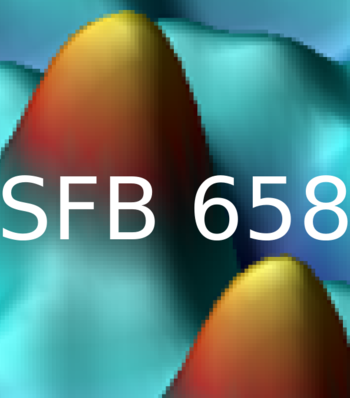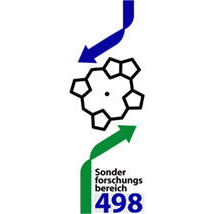Completed
Physics Department of FU Berlin coordinated these research centers.
The collaborative research centre investigated molecular switching processes driven by external excitations in well defined molecular systems at solid surfaces. Scientists focused on reversible conformational changes of individual molecules and ensembles leading to measurable changes of functional (e.g. optical, electronic or magnetic) properties of the system. The focus on elementary processes included investigation of all individual steps, physical parameters and interactions which induce and influence the process of molecular switching.
Research grounded on various complementary methods from synthesis of molecular systems, characterization of structural and electronic properties by quantitative surfaces sciences techniques and theoretical modelling. The long-term goals were to develop novel functionalities, like cooperative switching processes, and criteria for applications in molecular functional devices.
Spokesperson
Professor Dr Martin Weinelt, since 7/2015
Professor Dr. Felix von Oppen, till 7/2015
Involved research groups
Brouwer, Fumagalli, Franke, Kuch, von Oppen, Reich, Weinelt, Groß, Pascual, Tegeder
Achievements
- around 430 publications
- 85 doctorates completed
- 5 strategic appointments
- 7 subproject leaders transfered
Participating institutions
- Freie Universität Berlin
- Humboldt University Berlin
- Technical University Berlin
- University Potsdam
- Fritz Haber Institute FHI)
- Paul-Drude-Institut für Festkörperelektronik (PDI)
SFB 658
Nature utilizes protein-cofactor interactions in order to optimize biological functions. The research center focused on the investigation of the interaction of the protein with organic cofactors and metal ions. These interactions were investigated using an approach combining various techniques from molecular biology, biochemistry, structure analysis, spectroscopy and theory.
The collaborative research centre consisted of seventeen scientific projects grouped according to the research goals focussed on the biological processes of electron and excitation energy transfer, conformational changes and signal transduction, and enzymatic cleavage of molecular hydrogen and water oxidation.
Spokesperson
Involved groups
Research Group Antontik / Stehlik, Research Group Weber, Research Group Haumann / Dau, Research Group Heyne
Participating institutions
- Freie Universität
- Charité - Universitätsmedizin Berlin
- Humboldt University Berlin
- Technical University Berlin
- Leibniz-Forschungsinstitut für Molekulare Pharmakologie (FMP)
The research goal was to learn to control electron and nuclear constellation in different material systems using ultrashort laser pulses. The motion sequences triggered in this way were to be characterized in time and, if possible, guided by appropriate design of the irradiated light fields in such a way that a stable, detectable final state was achieved.
In the first funding period, the focus was on the analysis of such photo-induced dynamic processes, both experimentally and theoretically. The optical excitation of the system was mostly performed with a pump pulse as short as possible, while the resulting change of the nuclear coordinates of the system was interrogated with a sample pulse that was also as short as possible and delayed in time.
In the second funding period, the goal of control was also increasingly realized by using more complex excitation fields. In the experiment, the researchers used suitable modulators for this purpose; complementary to this, the theory of optimal control was expanded. And so, in the area of small, still manageable systems with few active degrees of freedom, there was a very gratifying convergence of theory and experiment, paving an essential part of the way toward more complex systems. Even in the more complex systems, the experimental results, in close cooperation with theory, offered very detailed insights into the dynamics of ultrafast photoinduced reactions.
Spokesperson
Participating institutions
- Freie Universität Berlin
- Helmholtz Zentrum Berlin
- The Hebrew University of Jerusalem
- Fritz Haber Institut der Max-Planck-Gesellschaft (FHI)
- Max Born Institute for Nonlinear Optics and Short Pulse Spectroscopy
- Humboldt University Berlin
- Tel-Aviv University
- University Potsdam
SFB 450
The researchers investigated ultrathin films consisting of a few monolayers of atoms and their electronic and magnetic properties as well as lattice vibrations and transport properties. Their goal was to better understand the relationship between structure, morphology and the physical properties of thin metallic films.
Spokesperson
Prof. Dr Karl-Heinz Rieder
Paricipating institutions
- Freie Universität Berlin
- Humboldt University Berlin
- Technical University Berlin
CRC 290
The scientific objective was to investigate the dynamics of physical and chemical subsequent processes after deposition of a local excitation energy in a molecular aggregate, which could be located in different environments. In addition to magnetic resonance methods, time-resolved spectroscopy with ultrashort laser pulses was used here for the first time, with which the electron dynamics after photoexcitation could be followed with a time resolution in the femtosecond range, allowing the observation of completely new effects.
Spokesperson
Prof Dr Dietmar Stehlik
Funding
DM 37.9 m
Participating institutions
- Freie Universität Berlin: Department of Physics, Department of Chemistry
- Fritz Haber Institute of the Max Planck Society
- Technical University Berlin
- Hahn Meitner Institute
Downloads
The researchers investigated the electronic structure of interfaces and solid/electrolyte interfaces as well as heterogeneous reactions at interfaces.
Spokesperson
Prof. Bennemann
Funding
DM 25.5m
Participating institutions
- Freie Universität: Department of Physics, Department of Chemistry
- Fritz Haber Institute
- Technical University Berlin
CRC 161 was one of the first collaborative research centers at Freie Universität. The field of work was the investigation of hyperfine interactions in excited nuclear states, molecules, and free atoms, as well as the electronic structure of condensed matter.
Spokespersons
Wilking (1972–73), Hüfner (1973–74), Matthias (1974–75) und Gabriel (1975–86)

